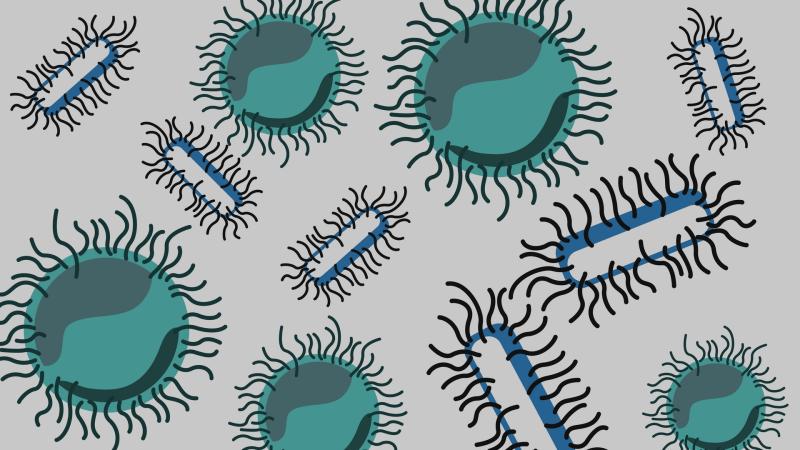
In 2008, a person was hospitalized in Sweden for a urinary tract infection--a common infection caused by bacteria that results in a burning sensation during urination. Often, a course of antibiotics should make the patient better. But what was remarkable in this case was that the infection persisted in spite of it being treated with a range of existing antibiotics! Baffled, the doctors examined the bacteria responsible for the infection.
What they found was a new gene in the bacteria that was making it survive despite the antibiotics. The bacteria, aptly named ‘superbugs’, had grown immune to the effects of antibiotics. Such superbugs infect roughly 2 million people every year, of which 23000 people fail to survive, according to the U.S. Centers for Disease Control and Prevention (CDC).
The culprit gene, in the bacteria causing the infection, was named the ‘New Delhi-metallo-beta-lactamase’, after New Delhi - the city that the Swedish person visited before he contracted the infection. Since then, NDM-1 has been identified in multiple bacterial infections across the country, causing havoc and rendering well-known antibiotics ineffective.
Antibiotics -- the double-edged sword
In the past century, our understanding of bacteria has helped us design the most effective drugs against them. Bacterial infections such as typhoid, tuberculosis, cholera, and pneumonia, which used to be the leading cause of mortality in the pre-antibiotic era, are today effectively cured with antibiotics. As a result, a person born today will live for an average of about 71 years, as compared to the lifespan of 47 years of those born before the 1950s. This astounding increase in 50% of one’s life expectancy is possible, thanks to the magic pills called antibiotics.
Sir Alexander Fleming's Nobel Prize-winning discovery of penicillin heralded the start of the ‘antibiotics era’. Since then, we have developed close to 100 different antibiotics that cure a range of bacterial infections. Thanks to their effectiveness, they were ubiquitous and widely used and became more accessible and affordable.
Antibiotics are not just used for tackling diseases caused in humans, but also animals. Cows, buffaloes, poultry, pigs, and fish are regularly treated with antibiotics to fight diseases or prevent them. While this step helps improve our yields and keep our animals healthy, the drugs creep into the food chain and enter our bodies when we eat any of these products.
There exists yet another tragic epilogue to the use, or ‘abuse’, of antibiotics. Statistics show that the efficiency of cure is decreasing as more and more bacteria become resistant to antibiotics of all types. In summary, the bacteria are getting stronger and antibiotics are losing the plot. But how do bacteria develop resistance to drugs that once used to kill them? The answer lies in evolution.
Evolving from a ‘bug’ to a ‘superbug’
Before delving into the evolution of superbugs, here is a brief summary of how antibiotics work, or used to work, against the bacteria. Some antibiotics restrict the growth of bacteria by preventing them from dividing; others kill them by interfering with the production of proteins essential for their survival. Many bacteria, fungi, and other micro-organisms naturally produce antibiotics. In fact, penicillin, the first antibiotic, was discovered in a liquid secreted by the mold Penicillium notatum.
If antibiotics are so strong to kill the bacteria completely, how then do bacteria develop resistance to antibiotics? Turns out, some bacteria are naturally resistant to antibiotics, while others acquire resistance over time. According to the theory of natural selection, organisms evolve naturally over time to develop traits that make it easy for them to survive in their environment. Antibiotics provide such an environment to the bacteria and enforce the survival of those bacteria that are either resistant to antibiotics or develop resistance over time.
The ‘selection pressure’ on the bacteria works very well. Every time a bacterium divides, it is likely to undergo a spontaneous genetic mutation, i.e. a random change in its DNA sequence. If you throw in an antibiotic on such bacterium, it will undergo a genetic mutation that enables it to make a substance that renders the antibiotics ineffective or eliminates it from the cell. Those bacteria that are successful in acquiring these mutations will grow, whereas the others will die. Over time, these bacteria will outcompete the non-resistant bacteria and render antibiotics ineffective. These antibiotics resistant bacteria are commonly called ‘superbugs’.
To make things further complicated and interesting, unlike humans who only transfer their genetic material to their offspring, bacteria can transfer their genetic material to any other unrelated bacteria. In a community of bugs, if you have one superbug to start with, over time, through gene-transfer, many more unrelated bugs will become superbugs.
To quantify and standardize the degree of antibiotics resistance, a group of international experts from the European Centre for Disease Prevention and Control and the Centers for Disease Control and Prevention, USA categorized superbugs as multi-drug resistant (MDR), extensively drug-resistant (XDR) and pan-drug resistant (PDR). MDRs are superbugs resistant to more than one class of antibiotics, XDRs are resistant to most antibiotics and PDRs – the most lethal of all, are resistant to all antibiotics.
India’s battle against ‘superbugs’
India has one of the world’s highest number of bacterial infections; tuberculosis, cholera, typhoid, pneumonia and a host of them. In fact, the country has the highest number of tuberculosis patients in the world, accounting for one-fourth of all TB patients in the world. Multi-drug resistant (MDR) and extensively drug-resistant (XDR) tuberculosis cases are increasingly reported.
Unlike the usual TB infection, treating MDR and XDR TB infections involve special diagnostic tests and combinations of rare antibiotics for longer durations. This makes the diagnoses difficult and treatment expensive. In a country like India, where 22% of the population still lives below poverty line, increased cost reduces the probability of people getting proper treatment, which leaves the infection uncured. With TB being an airborne disease, one infection left uncured could propagate to many such infections and lead to an epidemic. This becomes more concerning in case of MDR and XDR TB, resulting in an incurable TB epidemic.
TB is not the only disease plagued by superbugs. Pneumonia, another common bacterial infection, also features in the list. A 2017 study, that examined the bacteria S. pneumoniae present in blood samples of children infected with pneumonia in multiple hospitals across 11 states found that most of these bacteria were resistant to first-line antibiotics – 66% were resistant to co-trimoxazole, 37% to erythromycin and 8% to penicillin. Another 2017 study that examined a more severe form of pneumonia found that 69% patients infected with the superbug K. pneumoniae did not survive. These superbugs were found to be resistant to both carbapenems – antibiotics used to treat MDR infections, and colistin – the last resort antibiotics which are used when no other antibiotics work. Similar rates of antibiotic-resistance have been detected in other bacterial infections like typhoid, cholera, and gonorrhea.
In summary, the threat is real and calls for immediate attention and action. What are some of those actions? What can we do about it? What are some hotspots of these bacterial infections? These are some of the questions that need immediate answers. The first step, however, is to understand the implications of antibiotic-resistant bacteria and spread awareness about the callous use of antibiotics.






